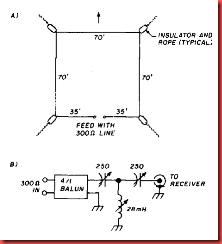This clever little antenna developed by JElDEU of Sagamihara City, Japan. Local hams were amused by the loop; hence the name - "hen" means curious in Japanese. "Henantenna" was quickly shortened to "Hentenna." It's shown in Figure 1. This antenna's virtue is that it has very little "wingspread"
The array has two one-sixth wave radiators separated vertically by a half wavelength. To feed them, connect the tips and tap the vertical wires with a coax feedline. Polarization is horizontal. Hentenna construction is simple. You use a single mast; try a TV-style pushup one. Make your horizontal sections out of 518-inch diameter aluminum tubing bolted to a mounting plate, and attach the plate to the mast with Ubolts. Use enamel-coated copper wire for the antenna's vertical sections. Feed the Hentenna with a balun and coax line. Run your feed wires from the balun to the vertical wires. Adjust for lowest SWR by moving the feed wires up or down the vertical wires. Copper alligator clips are ideal for this; you can remove them and make joint solders when you find the correct points. The points should be about 36 inches above the bottom tube for 10 meters. The Hentenna provides a figure eight pattern at right angles to the antenna plane. Gain is estimated at about 2.5 dB over a dipole. Bandwidth is very broad. By changing the length of the vertical wires, you can move the design frequency to any point in the 10-meter band.







![clip_image002[1] clip_image002[1]](https://blogger.googleusercontent.com/img/b/R29vZ2xl/AVvXsEindArgHSUPw3e3wG5iU1Bcd13HRIllySrbxm5WaZq2Bcw5d4S-bE1YnH0vJbvkhZYr9tGS5IjODNH-XxcDenTsCnLmyLhf6OUVGp_ctYFsL8nWTqJiAOfZBKrNl3KtDf8YDyBhbOzlCrQ/?imgmax=800)




















